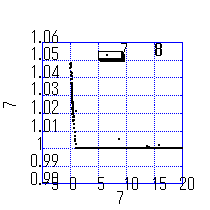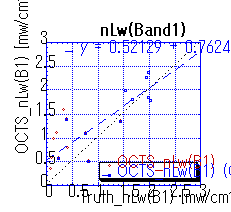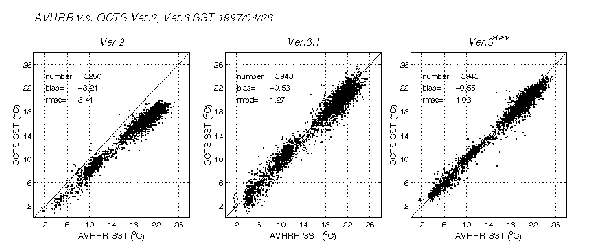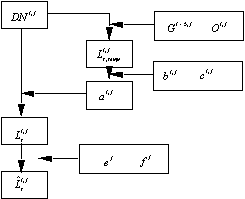EORC / OCTS CAL/VAL group
masanobu shimada
ver. 0 Feb. 5 1998
ver. 1 Feb. 9 1998
ver. 1.1 Feb. 10 1998
Members
OCTS team (NASDA staff)
Hiroshi Kawamura (Leader) Kamu@ocean.caos.tohoku.ac.jp
Masanobu Shimada (Subleader 1) shimada@eorc.nasda.go.jp
Yasuhisa Nakamura (Subleader 2) nakamura@eorc.nasda.go.jp
Hiromi Oaku (Calibration Group Leader) oaku@eorc.nasda.go.jp
Hiroyuki Oguma (Application Group Leader) oguma@eorc.nasda.go.jp
Yasushi Mitomi (Algorithm Group Leader) mitomi@eorc.nasda.go.jp
Akira Mukaida (Validation Group Leader) mukaida@restec.or.jp
Hiroshi Murakami (Application Group Leader) murakami@eorc.nasda.go.jp
Supporting Scientists
Hajime Fukushima (Tokai University)
Ken Furuya (University of Tokyo)
Yoshiaki Honda (Chiba University)
Joji Ishizaka (National Institute for Resources and Environment)
Motoaki Kishino (Institute of Physical and Chemical Research)
Satuki Matusmura (National research institute for far Seas Fineries)
Masao Moriyama (Nagasaki University)
Teruyuki Nakajima (Tokyo University)
Futoki Sakaida (Kobe University of Mercantile Marine)
Sei-ichi saito (Hokkaido University)
Toshiro Saino (Nagoya University)
Yasuhiro Senga (Tokai University)
Sumio Tannba (Iwate University)
In this document, we present the calibration and validation results
of the OCTS version 3 products, which are mainly composed of the
chlorophyll-a concentration (CHL-a), the normalized water leaving
radiance (nLw), and the sea-surface temperature (SST). Calibrating
OCTS is to characterize the inter-detector sensitivity, dark current
property, and absolute sensitivity using internal and external
calibration sources (i.e., AVIRIS underflights). Validation of
OCTS tunes the atmospheric correction equation by the vicarious
method which uses the in-situ measurement of nLw and the atmosphere,
and then, compares the estimated CHL-a and the in-situ data.
It tunes the SST retrieval equation. We acquired 17 in-situ data
for CHL-a, 11 data for nLw, and 225 for SST. We selected the
vicarious calibration coefficients which minimize the residuals
for CHL-a within 68% and nLw at 128 % (band 4) to 94 % (band 2).
SST was also verified as less than 0.70 K. Geometric accuracy
was improved to around 1.3 km. Stripes in the Ocean Color products
and the SST products were reduced much more than in previous products.
Appendix also introduces a method for radiometrically converting
from the previous version to the version three products.
1. MAIN CHANGES IN VERSION 3 SOFTWARE
1.1 Atmospheric Correction Method
An OCTS-type atmospheric correction algorithm was adopted as
in the version 2 software. Several bugs were fixed, and the processing
stability was improved. The aerosol selection scheme was improved
for quicker convergence.
1.2 Vicarious Calibration and Validation
The calibration coefficients were determined in the vicarious
approach using the in-situ data simultaneously acquired during
the OCTS passages. Those data were the aerosol type, optical
thickness, nLw, CHL-a, etc. A total of 17 CHL-as and 11 nLws
were screened as the errorless measurements that were acquired
as simultaneously as OCTS observation. Calibrations using the
internal lamps and AVIRIS underflight data were conducted. However,
this version does not adopt the calibration coefficients derived
by those results. The OCTS CHL-a data were compared with the
in-situ data.
1.3 Stripes
The stripe elimination function was enhanced significantly compared
to the previous version software. This function was modified
to enable the detector normalization coefficients dependent on
the radiance. (This means we assume nonlinearity in the sensitivity)
These calibration coefficients were calculated using the uniform
and the various intensity areas. Weak stripes, however, still
remain in the larger scanning area. SST stripes were reduced
by applying detector normalization coefficients measured from
the uniform ocean area. These improvements also removed the stripes
in the global products.
1.4 Geometric Location Accuracy
Geometric location accuracy was improved to an error of around
1 km by determining the three offsets in pitch, roll, and yaw
so as to minimize the least square error between OCTS pixel location
and the ground-control points. Ground-control points were selected
from the Japan islands. Global error assessment is a concern
as it is in other products.
1.5 Registration
Registration data is originally provided from the ground measurement
at the factory. The land products such as the vegetation index
require accuracy. Trial-and-error parameter modification improved
the registration accuracy slightly.
1.6 Flag Information
Flag information was tuned more confidently than before. The
updated flags are the near cloud, land mask, absorptive aerosol
flag, identification of the cocolisophere, etc. Land mask information
was blocked to enable viewing the ocean color and SST information
in the lakes, inland seas, and ponds.
1.7 Cloud Screening
The cloud screening process was improved to exclude suspicious
clouds.
1.8 Binned Products
Image quality of the binned products was improved very much.
2.1 Principle
2.1.1 Algorithm
The equations governing the responses among the solar irradiance,
atmosphere, ocean system, and sensor characteristics are given
below:
A. OCTS digital number - input radiance
The relationship between the OCTS measurements (digital number
(DN)) and the input radiance is modeled by:

where Lti,j
is the input radiance to the ith
detector of jth
band of OCTS (mW/str/cm2/mm);
DNi,j,
the digital number; Oi,j,
the offset of OCTS sensor which is measured in the night time;
ai,j,
the detector normalization coefficients (relative calibration
coefficients to the reference detector whose detector number is
five); Gi=5,j,
the absolute gain of the i = 5th
detector; and Fdata,
a reflection property of the scanning mirror which changes as
the function of the tilt angle. Fdata
measures i.e., 0.974 for band 1 at tilt angle of 20 degrees.
Exact expression of Fdata
is given in Appendix 3.
B. Water leaving radiance - input radiance
The input radiance to the OCTS can be expressed
by the following equations


where 

This model can work for ten different aerosol
types to describe the atmospheric radiation properties in any
ocean area (Table 1). More detailed information can be provided
by Nakajima et. al.[2] and Fukushima et. al.[4][6][7]
Table 1 Aerosol models installed in OCTS software
Model number Aerosol type Humidity
1 Oceanic 50
2 Oceanic 80
3 Oceanic 90
4 Coastal 50
5 Coastal 80
6 Coastal 90
7 Stratospheric 50
8 Stratospheric 80
9 Stratospheric 99
10 Absorptive
C. Ocean products - water leaving radiance
The relationship between the oceanic materials and the water leaving
radiance is empirically expressed by:

The empirical models adopted for the OCTS
data processing subsystem can be found in Kishino et. al.[3].
2.1.2 Definition of the terms
Before the description of the report, we
define the terms on calibration and validation. The process flow
of these works for ocean color is shown in Fig. 1. Same process
flow is valid for sea surface temperature. Calibration is defined
to determine the accurate conversion equation from DN to the input
radiance (Lt)
at the sensor input. Validation contains two processes: first,
the algorithm tuning (vicarious calibration) that adjusts the
given radiance so as to meet with Eq. (2), and second, the evaluation
of the estimated values.

Fig. 1 Overview of the process flow
for ocean color case.
2.2 Calibration
2.2.1 Radiometric calibration
A Absolute Calibration
Three data sources were used for calibrating
the OCTS measured input radiance. They are the preflight calibration
data, optical lamp data, and AVIRIS underflights of OCTS. Appendix
1 summarizes the process flow of the radiometric calibration.
(1) Preflight calibration data
The preflight calibration data acquired at the factory were to
relate the input radiance (Lt)
(mW/str/m2/um)
and the digital number (DN) for each detector and each band.
The measurement data were obtained by using the integration sphere
[1].
(2) Optical lamp data
The two calibration lamps were used every 42 days or so, and the
data were evaluated in terms of stability, power loss, and the
usablity for the calibration sources. The lamp data were assumed
as almost constant over eight months or slightly loosing sensitivity.
Those data were used to evaluate the radiometric stability.
(3) AVIRIS data
Four AVIRIS underflights of the OCTS were conducted off California,
USA, on Nov. 7, 1996, and Feb. 28, March 4, and May 20, 1997.
The best possible co-registered data were used for evaluating
the OCTS stability and its absolute value determination. Fig
1b shows the direct comparison of AVIRIS and OCTS data.
Although these three measurements (plus the
vicarious calibration method) are compared, none of the two methods
match (Fig. 2a shows the across band sensitivity differences for
four different calibration signal sources). We could not conclude
which data sources should be relied on. We will therefore continue
using the gains Gi=5,j
from preflight calibration coefficients in version 3. Offsets
of each detector and channel are determined by evaluating the
nighttime data. Those data, Oi,j
and Gi=5,j,
are shown in Tables I and IIs (II-1, II-2, II-3, and II-4). For
more detailed information, refer to [5].

a) b)
Fig. 2 Comparison of calibration coefficients
(after H. Oaku)
B Relative calibration - detector normalization
We performed relative calibration of the 80 detectors at visible
and infrared bands. If the sensitivities of all the detectors
in a band were determined correctly, the image must not suffer
from the stripes. However, many stripes were visible in images
when we applied the Gi,j (preflight
data) or the lamp data. We statistically evaluated the interband-sensitivity
variations over 62 different targets on the Earth surface collected
from ocean and land, different scan angles, and different tilt
angles. Based on this, we made the following interband sensitivity
model as a function of the input radiance:


where ai,j
is the detector normalization coefficient for the ith
detector of jth
band; bi,j,
the slope of the ijth
detector; Ltempi,j,
each detector's input radiance converted by using the gain of
the fifth detector and each detector's offset; ci,j,
the offset; LCi,j,
the criteria by which a different normalization curve is selected.
The detector normalization coefficients are given in Tables III,
IV, and V. The sample relationship between the ai,j
and the input radiance for the seventh detector of bands 6 and
8 is shown in Fig. 3.
Note that
the above detector normalization coefficients were determined
by using the ocean-normal data and land normal data,
then, the images in the other gains may be corrected slightly
different.

Fig. 3 Detector normalization coefficients
aij.
a) 7 th detector of band 6; b) 7 th detector of band 8.
2.2.2 Geometric calibration
1) Offset of the attitude values
The geometric accuracies of the OCTS data
products are listed in Table 2. Roughly, these values are within
1.31 km. This accuracy was attained by tuning the three components
for the alignments between the OCTS and the satellite base plate,
and three alignments in the OCTS scanning mirror so as to minimize
the least square error of estimated ground points and the measured
ground control points. In total 187 ground control points were
measured[8].
Table 2 Geometric accuracy improvement by tuning the sensor alignment (km)
Average Standard deviation
Total Cross Along Total Cross Along
Error average 0.15 0.017 1.31 1.03 0.81
Note 187 ground control points were sued for this tuning.
2) Registration parameters
The band-to-band registration is a key parameter for generating
satisfactory products for land applications. The complexity of
the detector alignment over twelve bands makes it difficult to
achieve perfect detector co-registration. The terrain height
also makes the co-registration difficult.
Table 3 Accuracy improvement by registration parameter
TBD TBD
2.3 Validation
2.3.1 Algorithm tuning (Vicarious calibration)
Vicarious calibration was conducted using (2) and the in-situ
data, such as nLw, aerosol quantities, and the atmospheric properties.
The complete datasets for determining the calibration coefficients
are very limited. The good datasets were acquired in the CALCOFI
experiments off California on November 1, 1997. The vicarious
calibration coefficients were selected through the competitive
works. Using the truth datasets which contain 11 data measurements,
six vicarious calibration coefficients were proposed from several
researchers (three from NASDA, two from Tokyo University, and
one from Tokai University). An analysis of the difference between
the estimated CHL-a and the true CHL-a determined the final calibration
coefficients. This conversion is summarized as follows:

where fj
and ej
are the tuning coefficients determined for each band.
2.3.2 Evaluation
We collected the in-situ data of CHL-a and
nLw world widely in collaboration with national and international
agencies and institutes. Out of more than thousands collected
in-situ data, those data that were acquired almost simultaneously
with OCTS under the cloud free condition were screened. There
are 17 CHL-a and 11 water-leaving radiance. Fig. 4-a) shows the
scatterogram for the estimated CHL-a and in-situ CHL-a and Fig.
4-b) shows that for the water leaving radiance at band 1. Table
4 summarizes the error statistics. We confirmed the relative
error of the CHL-a to be 68% and the water-leaving radiance to
be 94 to 128 %. The standard deviation of the error at band 5
exceeds 400%. This may requires the improvement of the calibration
accuracy.

Fig. 4 Error distribution a), the
truth CHL-a and estimated CHL-a; b), water leaving radiance.(after
Y. Mitomi)
Table 4 Accuracy of the CHL-a and nLw
Items Accuracy (%)
nLw1 96
nLw2 94
nLw3 112
nLw4 129
nLw5 417
CHL-a 68
2.4 Discussion
We acquired as many in-situ data measurements as possible after
the satellite launch. During eight months operation from Nov.
1996 to June 1997, we collected 1236 measurements for CHL-a, and
338 for water-leaving radiance. However, the usable data sets
were limited due to different time scales, locations, or cloud
coverage to about ten for both types of data. This shows that
acquisition of the best possible matched data sets is extremely
difficult. The success ratio is only 1% (ten divided by one thousand).
3.1 Calibration
Calibration is the validated transformation of the Digital Number
to the integrated radiance over the filter characteristics. The
unit of the converted value is mW/str/m2.

where L0i,j
is the integrated radiance over each band; Voi,j,
the observed voltage; VIi,j,
the voltage to the black body; fo,
constants; and Og,
constants. 
3.1.1 Absolute calibration
This has not been completed yet. We are
expecting more evaluation using the IMG data acquired with OCTS
simultaneously in time and space.
3.1.2 Relative calibration
In the same way as in visible bands, sensitivity
variation over ten detectors generates banding across the track.
The reasons are not known. We can eliminate these stripes by
using a two-step operation: a) coarse filtering in converting
DN to radiance and b) fine filtering for SST value (moving average
filter).
A Coarse filtering
We apply the detector normalization factor
to Eq. (7) to eliminate the stripes. The application is as follows:

where ai,j
is the detector normalization factor for the ith
detector of the jth
band. These coefficients are given in Table VIII.
B Fine filtering
The above banding is mainly caused by the
sensitivity variation at band 12. The temperature difference
between 11 and 12 is related to the atmospheric disturbance over
the ocean. Spatial filtering around 14 km * 14 km does not affect
the sea surface temperature. This is why we apply spatial filtering
for the T11-T12.
3.2 Validation
The equation for converting from the brightness
temperature to the sea surface temperature (MCSST) is empirically
determined using the truth data as:



where Ti,j
is the brightness temperature (K); q,
the zenith angle; 
The comparison of the AVHRR data and the
SST data estimated from the measurement data is shown in Fig.
5.

4 Conclusions
We presented a calibration and validation results of the version
3 products. We have also presented the coefficients used in the
version 3 products. We confirmed that the version 3 products
are accurate enough for scientific use (Fig 6 for CHL-a and Fig.
7 for SST map near Japan of April 26 1997). The representative
accuracies are as follows: CHL-a estimation accuracy, 68%; water-leaving-radiance
estimation accuracy, 94%; SST accuracy, 0.70K; and geometric accuracy,
1.3 km.
References
[1] NASDA document, "OCTS description and database," prepared by Mitsubishi electric cooperation, March 1994.
[2] T. Nakajima,
[3] Kishino, "
[4] H. Fukushima,
[5] H. Oaku, et. al., "Calibration and validation of OCTS," submitted to EUROPT'97
[6] Y. Mitomi, et. al., "".
[7] NASDA contract report by NEC, "Initial evaluation of OCTS," 1997 Sept.Appendix 1 Radiometric conversion for Ocean color
A.1.1 Process flow
The databases used for the radiometric calibration and validation
are summarized. A flowchart to convert DN to the input radiance
is shown in Fig. A-1.

Fig. A-1 A flowchart
for converting DN to input radiance (Visible and infrared band).
A.1.2 Calibration coefficients
bij gradient of the detector normalization slope -> Table III (gain_slope.data1)
cij offset of the detector normalization slope -> Table IV (gain_off.data1)
Lcij radiance at the two regions' boarder -> Table V (gain_cri.data)
Oij basic offset of the detector normalization -> Table I (Offsets)
Gij gain of the calibration coefficients -> Table II-1 (gain_base0-ocean normal)
-> Table II-2 (gain_base0-ocean high)
-> Table II-3 (gain_base0-land normal)
->
Table II-4 (gain_base0-land
high)
A.1.3 Validation coefficients (algorithm tuning)
fj Amplification factor -> Table VI
ej
Offsets -> Table VII
Appendix 2 Radiometric conversion for Sea Surface Temperature
A.2.1 Process flow
The data base used for the radiometric calibration and validation
is summarized. A flowchart to convert DN to the input radiance
is shown in Fig. A-2.

Fig. A-2 Flowchart
to convert DN to the input radiance (Visible and infrared bands).
A.2.2 Calibration coefficients
aij detector normalization factor -> Table VIII
f() conversion table -> Table IX
A.2.3 Validation coefficients
gj
empirical conversion coefficients -> Table X
Table I Offsets
0.795 0.639 0.036 0.090 0.000 0.486 0.000 3.570
0.450 0.036 0.467 0.915 0.000 1.421 0.831 2.893
0.839 0.775 0.065 1.197 0.478 0.000 1.314 0.396
0.228 0.529 1.142 1.255 0.088 0.650 0.246 7.667
0.510 0.341 0.860 0.133 0.025 0.000 0.494 0.000
0.333 0.017 1.163 0.856 0.050 2.761 2.151 0.000
0.478 0.071 1.036 2.418 0.669 2.575 1.097 0.000
0.499 0.089 0.096 0.000 0.916 1.021 1.099 5.335
0.863 0.187 1.431 0.595 0.000 1.428 2.098 2.272
1.013 0.017 1.571 1.577
0.186 2.338 1.990 0.346
/*
Table II-1 gain_base0 (Ocean-normal)(W/m2/str/mm)
6.01 6.09 7.29 8.19 10.45 16.10 23.81 48.84
6.01 6.09 7.29 8.19 10.45 16.10 23.81 48.84
6.01 6.09 7.29 8.19 10.45 16.10 23.81 48.84
6.01 6.09 7.29 8.19 10.45 16.10 23.81 48.84
6.01 6.09 7.29 8.19 10.45 16.10 23.81 48.84
6.01 6.09 7.29 8.19 10.45 16.10 23.81 48.84
6.01 6.09 7.29 8.19 10.45 16.10 23.81 48.84
6.01 6.09 7.29 8.19 10.45 16.10 23.81 48.84
6.01 6.09 7.29 8.19 10.45 16.10 23.81 48.84
6.01 6.09 7.29 8.19 10.45 16.10 23.81 48.84
*/
/*
Table II-2 gain_base0 (ocean-high)(W/m2/str/mm)
9.01 9.14 10.97 12.29 15.59 23.55 34.78 71.52
9.01 9.14 10.97 12.29 15.59 23.55 34.78 71.52
9.01 9.14 10.97 12.29 15.59 23.55 34.78 71.52
9.01 9.14 10.97 12.29 15.59 23.55 34.78 71.52
9.01 9.14 10.97 12.29 15.59 23.55 34.78 71.52
9.01 9.14 10.97 12.29 15.59 23.55 34.78 71.52
9.01 9.14 10.97 12.29 15.59 23.55 34.78 71.52
9.01 9.14 10.97 12.29 15.59 23.55 34.78 71.52
9.01 9.14 10.97 12.29 15.59 23.55 34.78 71.52
9.01 9.14 10.97 12.29 15.59 23.55 34.78 71.52
*/
/*
Table II-3 gain_base0 (land-normal)(W/m2/str/mm)
6.02 6.09 3.82 3.39 3.05 3.63 4.15 4.93
6.02 6.09 3.82 3.39 3.05 3.63 4.15 4.93
6.02 6.09 3.82 3.39 3.05 3.63 4.15 4.93
6.02 6.09 3.82 3.39 3.05 3.63 4.15 4.93
6.02 6.09 3.82 3.39 3.05 3.63 4.15 4.93
6.02 6.09 3.82 3.39 3.05 3.63 4.15 4.93
6.02 6.09 3.82 3.39 3.05 3.63 4.15 4.93
6.02 6.09 3.82 3.39 3.05 3.63 4.15 4.93
6.02 6.09 3.82 3.39 3.05 3.63 4.15 4.93
6.02 6.09 3.82 3.39 3.05 3.63 4.15 4.93
*/
/*
Table II-4 gain_base0 (land high)(W/m2/str/mm)
9.02 8.43 5.76 5.11 4.58 5.41 6.21 7.35
9.02 8.43 5.76 5.11 4.58 5.41 6.21 7.35
9.02 8.43 5.76 5.11 4.58 5.41 6.21 7.35
9.02 8.43 5.76 5.11 4.58 5.41 6.21 7.35
9.02 8.43 5.76 5.11 4.58 5.41 6.21 7.35
9.02 8.43 5.76 5.11 4.58 5.41 6.21 7.35
9.02 8.43 5.76 5.11 4.58 5.41 6.21 7.35
9.02 8.43 5.76 5.11 4.58 5.41 6.21 7.35
9.02 8.43 5.76 5.11 4.58 5.41 6.21 7.35
9.02 8.43 5.76 5.11 4.58 5.41 6.21 7.35
*/
Table III gain_slope.data1
1.924e-03 1.878e-03 2.430e-03 2.268e-03 8.700e-03 2.173e-02 2.899e-02 3.328e-02
5.491e-04 2.886e-04 1.420e-03 1.349e-03 6.950e-03 1.458e-02 1.187e-02 6.900e-02
3.290e-04 1.938e-04 7.084e-04 1.081e-03 2.409e-03 -4.414e-03 2.035e-03 2.825e-02
-8.055e-05 -1.067e-04 4.205e-04 6.220e-04 1.141e-03 8.971e-03 -1.887e-04 2.670e-02
-0.000e+00 -2.843e-17 -7.723e-17 4.480e-17 -4.642e-16 7.957e-16 -5.036e-18 -7.733e-16
-1.751e-04 -3.546e-04 -1.584e-04 2.630e-05 -1.400e-02 6.836e-03 -1.790e-02 -1.316e-02
-1.233e-04 -2.532e-04 -2.449e-04 1.398e-04 1.443e-04 9.463e-03 -7.544e-03 -4.519e-02
-5.318e-05 -1.300e-04 -1.823e-04 -3.984e-04 7.819e-05 6.749e-03 -5.816e-05 5.561e-02
2.042e-05 2.906e-04 3.237e-04 -7.054e-05 -6.178e-03 7.888e-03 -1.286e-02 2.095e-02
2.954e-04 7.677e-04 9.302e-04 6.460e-04
1.334e-03 1.220e-02 -7.916e-03 3.206e-02
Table IV gain_off.data1
1.0396 1.0404 0.99825 1.0001 0.98247 0.95390 0.98257 0.96288
1.0130 1.0214 0.99911 0.99950 0.98570 0.97425 0.99784 0.96450
0.99925 1.0068 1.0023 0.99372 0.99086 1.0109 1.0039 0.97428
0.99938 0.99656 1.0015 0.99600 0.99179 0.97272 1.0065 0.97200
1.0000 1.0000 1.0000 1.0000 1.0000 1.0000 1.0000 1.0000
1.0061 1.0036 1.0014 0.99883 1.0348 0.97966 1.0294 1.0141
1.0095 1.0047 1.0044 1.0013 0.99576 0.97255 1.0087 1.0477
1.0141 1.0192 1.0021 1.0029 1.0007 0.98191 1.0043 0.96488
1.0230 1.0259 1.0072 1.0053 1.0313 0.97790 1.0219 0.97535
1.0371 1.0507 1.0109 0.99999 1.0039
0.97420 1.0223 0.96054
Table V gain_cri.data
1000.0 1000.0 1000.0 1000.0 4.3132 2.3050 1.1184 0.96497
1000.0 1000.0 1000.0 1000.0 3.4964 2.3147 1.0242 0.58696
1000.0 1000.0 1000.0 1000.0 4.6238 2.0176 1.0421 0.91042
1000.0 1000.0 1000.0 1000.0 4.5604 2.8178 1000.0 1.1985
1000.0 1000.0 1000.0 1000.0 0.0000 0.0000 1000.0 0.0000
1000.0 1000.0 1000.0 1000.0 2.4500 3.2675 1.3655 0.61841
1000.0 1000.0 1000.0 1000.0 22.447 2.9004 1.1498 1.0548
1000.0 1000.0 1000.0 1000.0 54.910 3.4208 1000.0 0.63148
1000.0 1000.0 1000.0 1000.0 3.4452 3.8160 0.77273 1.1763
1000.0 1000.0 1000.0 1000.0 1000.0
2.9319 0.044229 0.98093
Table VI Amplification factor
1.1095279 1.0080781 0.9443458 1.0075835
1.0369337 0.9277923 0.9048486 0.764515
Table VII Offsets
0 0 0 0 0 0 0 0
Table VIII normalization factor (SST)
1.0004374 0.99741285 0.99692435 0.99922403
0.99380308 0.99855709 0.99830716 0.99931177
0.99506745 0.9989685 0.99962235 0.99948338
0.99424178 1.00066825 1.0002982 1.00142693
1 1 1 1
1.0003703 1.00006226 0.99990042 0.99979971
0.99560993 0.99917597 0.99897734 0.99997979
0.99707445 0.99809563 0.99817961 1.0013679
0.99344553 0.99737136 0.9977094 1.00178284
0.98483269 0.99610934 0.99531633 1.00143665
Table IX :
Temperature(K) #9 #10 #11 #12
2.200000e+02 1.185682e-03 6.010673e-01 1.247574e+00 2.169465e+00
2.201000e+02 1.194967e-03 6.031693e-01 1.250950e+00 2.174886e+00
2.202000e+02 1.204317e-03 6.052767e-01 1.254333e+00 2.180316e+00
2.203000e+02 1.213732e-03 6.073896e-01 1.257721e+00 2.185754e+00
2.204000e+02 1.223213e-03 6.095079e-01 1.261115e+00 2.191201e+00
2.205000e+02 1.232759e-03 6.116317e-01 1.264516e+00 2.196657e+00
2.206000e+02 1.242371e-03 6.137609e-01 1.267923e+00 2.202122e+00
2.207000e+02 1.252050e-03 6.158956e-01 1.271335e+00 2.207595e+00
2.208000e+02 1.261796e-03 6.180359e-01 1.274754e+00 2.213077e+00
2.209000e+02 1.271609e-03 6.201816e-01 1.278179e+00 2.218568e+00
more data are provided in the file
(NEW.TIR)
Table X :
i 1 2 3 4 5 6
g -29.553529 1.1118699 4.2586536 -0.6445829
1.4122749 -0.5512104
Table XI

band9 band10 band11 band12
0.8 0.0 1.9 1.0
0.9 0.4 1.4 0.9
1.5 1.0 2.4 0.2
0.6 2.7 1.5 0.0
1.4 2.5 1.6 0.7
1.3 0.1 2.0 1.5
1.7 1.3 1.0 0.9
0.5 1.0 1.0 0.3
0.1 3.2 0.6 1.2
0.0 3.6 1.0 0.3
Appendix. Radiometric Conversion from Previous Version to This Version
TBD
Appendix 3 Exact expression of Fdata
Exact expression of Fdata
is given by

where h is the reflection coefficient
of the scanning mirror, bd,
bp,
bam,
bad
are the factors correcting the temperature dependency, k is the
number for tilt. However, bs (bd,
bp,
bam,
bad)
are negligibly small and set to be zero.
Table A.1 Reflection coefficients (h)
tilt angle
band -20(k=0) 0(k=1) 20(k=2)
1 0.974 1.000 0.980
2 0.984 1.000 0.997
3 0.990 1.000 0.997
4 0.992 1.000 0.996
5 0.994 1.000 0.995
6 0.995 1.000 0.995
7 0.996 1.000 0.995
8 0.996 1.000 0.995
9 1.000 1.000 1.003
10 1.008 1.000 0.992
11 0.982 1.000 0.992
12 0.975 1.000 0.981
![]() Earth Observation Resea
rch Center
Earth Observation Resea
rch Center